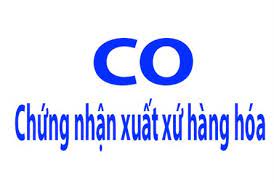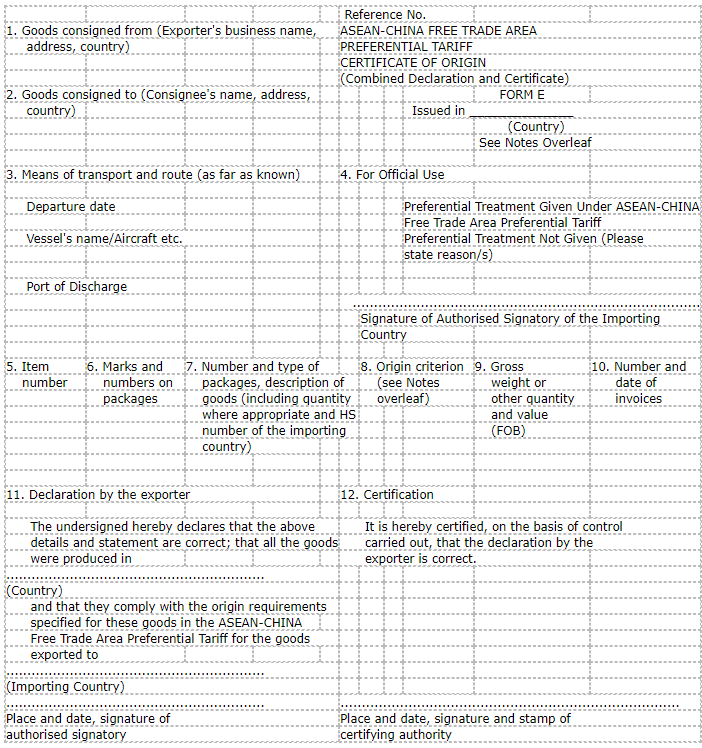Hiện nay có thể bạn đọc sẽ thắc mắc về khái niệm hay các quy định liên quan đến Chứng nhận xuất xứ hàng hóa. Để hiểu thêm về vấn đề này, mời bạn đọc cùng theo dõi bài viết về Mẫu giấy chứng nhận xuất xứ hàng hóa Trung Quốc cùng với ACC:

Mẫu giấy chứng nhận xuất xứ hàng hóa Trung Quốc
1. Chứng nhận xuất xứ hàng hóa là gì?
Chứng nhận xuất xứ hàng hóa - viết tắt là C/O - tên đầy đủ tiếng Anh là Certificate of Origin: Chứng nhận xuất xứ hàng hóa chính là giấy chứng nhận xuất xứ hàng hóa, được cấp bởi cơ quan có thẩm quyền của nước xuất khẩu hàng hóa cho phép hàng hóa được sản xuất tại nước đó. Chứng nhận xuất xứ hàng hóa cần phải tuân thủ theo đúng quy định của nước xuất khẩu và cả nước nhập khẩu theo đúng quy tắc xuất xứ.
Khoản 4 Điều 3 Nghị định 31/2018/NĐ-CP định nghĩa về Giấy chứng nhận xuất xứ hàng hóa như sau: Giấy chứng nhận xuất xứ hàng hóa là văn bản hoặc các hình thức có giá trị pháp lý tương đương do cơ quan, tổ chức thuộc nước, nhóm nước, hoặc vùng lãnh thổ xuất khẩu hàng hóa cấp dựa trên quy định và yêu cầu liên quan về xuất xứ, chỉ rõ nguồn gốc xuất xứ của hàng hóa đó.
Mục đích của Chứng nhận xuất xứ hàng hóa chính là việc chứng minh hàng hóa đó có xuất xứ rõ ràng, hợp pháp tới thuế quan và những quy định khác của pháp luật về việc xuất nhập khẩu của cả hai bên: Nhập khẩu và xuất khẩu..
2. Các loại Giấy Chứng nhận xuất xứ hàng hóa
Hiện nay có những loại Chứng nhận xuất xứ hàng hóa phổ biến sau đây:
- C/O mẫu A (Mẫu C/O ưu đãi dùng cho hàng xuất khẩu của Việt Nam)
- CO form B (Mẫu C/O không ưu đãi dùng cho hàng xuất khẩu của Việt Nam)
- C/O mẫu D (các nước trong khối ASEAN)
- C/O Form E: hàng xuất khẩu sang Trung Quốc và các nước ASEAN thuộc diện hưởng ưu đãi thuế quan theo hiệp định ASEAN – Trung Quốc.
- C/O Form AK (ASEAN – Hàn Quốc): hàng xuất khẩu sang Hàn Quốc và các nước ASEAN thuộc diện hưởng ưu đãi thuế quan theo hiệp định ASEAN – Hàn Quốc.
- C/O Form AJ (ASEAN – Nhật Bản).
- C/O Form AI (ASEAN – Ấn Độ).
- C/O Form AANZ (ASEAN – Australia – New Zealand).
- C/O Form VJ (Việt Nam – Nhật Bản): Hàng xuất khẩu sang Nhật Bản thuộc diện hưởng ưu đãi thuế quan theo hiệp định Việt Nam – Nhật Bản.
- C/O Form VC (Việt Nam – Chile).
- C/O Form S (Việt Nam – Lào).
- C/O Form GSTP: hàng xuất khẩu sang các nước tham gia hệ thống ưu đãi thương mại toàn cầu (GSTP).
- C/O Form ICO: cấp cho sản phẩm từ cà phê trồng và thu hoạch tại Việt Nam xuất khẩu sang tất cả các nước theo quy định của Tổ chức cà phê thế giới (ICO).Giấy chứng nhận xuất xứ hàng hóa – C/O cho mặt hàng Cà phê Việt Nam
- C/O Form Textile (gọi tắt là form T) cấp cho hàng dệt may xuất khẩu sang EU theo hiệp định dệt may Việt Nam – EU.
- C/O Form Mexico: (thường gọi là Anexo III) cấp cho hàng dệt may, giày dép xuất khẩu sang Mexico theo quy định của Mexico.
- C/O Form Venezuela: cấp cho hàng xuất khẩu sang Venezuela theo quy định của Venezuela.
- C/O Form Peru: cấp cho hàng giày dép xuất khẩu sang Peru theo quy định của Peru.
3. Mẫu giấy chứng nhận xuất xứ hàng hóa Trung Quốc
Original (Duplicate/Triplicate/Quadruplicate)

OVERLEAF NOTES
1. Member States which accept this form for the purpose of preferential treatment under the ASEAN-CHINA Free Trade Area Preferential Tariff:

2. CONDITIONS: The main conditions for admission to the preferential treatment under the ACFTA Preferential Tariff are that goods sent to any Member States listed above:
(i) must fall within a description of products eligible for concessions in the country of destination;
(ii) must comply with the consignment conditions that the goods must be consigned directly from any ACFTA Member State to the importing Member State but transport that involves passing through one or more intermediate non-ACFTA Member States, is also accepted provided that any intermediate transit, transshipment or temporary storage arises only for geographic reasons or transportation requirements; and
(iii) must comply with the origin criteria given in the next paragraph.
3. ORIGIN CRITERIA: For exports to the above mentioned countries to be eligible for preferential treatment, the requirement is that either:
(i) The products wholly obtained in the exporting Member State as defined in Rule 3 of the ASEAN-China Rules of Origin;
(ii) Subject to sub-paragraph (i) above, for the purpose of implementing the provisions of Rule 2 (b) of the ASEAN-China Rules of Origin, products worked on and processed as a result of which the total value of the materials, parts or produce originating from non-ACFTA Member States or of undetermined origin used does not exceed 60% of the FOB value of the product produced or obtained and the final process of the manufacture is performed within territory of the exporting Member State;
(iii) Products which comply with origin requirements provided for in Rule 2 of the ASEAN-China Rules of Origin and which are used in a Member State as inputs for a finished product eligible for preferential treatment in another Member State/States shall be considered as a product originating in the Member State where working or processing of the finished product has taken place provided that the aggregate ACFTA content of the final product is not less than 40%; or
(iv) Products which satisfy the Product Specific Rules provided for in Attachment B of the ASEAN-China Rules of Origin shall be considered as goods to which sufficient transformation has been carried out in a Party.
If the goods qualify under the above criteria, the exporter must indicate in Box 8 of this form the origin criteria on the basis of which he claims that his goods qualify for preferential treatment, in the manner shown in the following table:
| Circumstances of production or manufacture in the first country named in Box 11 of this form | Insert in Box 8 |
| (a) Products wholly produced in the country of exportation (see paragraph 3 (i) above) |
“X” |
| (b) Products worked upon but not wholly produced in the exporting Member State which were produced in conformity with the provisions of paragraph 3 (ii) above | Percentage of single country content, example 40% |
| (c) Products worked upon but not wholly produced in the exporting Member State which were produced in conformity with the provisions of paragraph 3 (iii) above | Percentage of ACFTA cumulative content, example 40% |
| (d) Products satisfied the Products Specific Rules | “Products Specific Rules” |
4. EACH ARTICLE MUST QUALIFY: It should be noted that all the products in a consignment must qualify separately in their own right. This is of particular relevance when similar articles of different sizes or spare parts are sent.
5. DESCRIPTION OF PRODUCTS: The description of products must be sufficiently detailed to enable the products to be identified by the Customs Officers examining them. Name of manufacturer, any trade mark shall also be specified.
6. The Harmonised System number shall be that of the importing Member State.
7. The term “Exporter” in Box 11 may include the manufacturer or the producer.
8. FOR OFFICIAL USE: The Customs Authority of the importing Member State must indicate ( ü ) in the relevant boxes in column 4 whether or not preferential treatment is accorded.
Việc tìm hiểu về Chứng nhận xuất xứ hàng hóa sẽ giúp ích cho bạn đọc khi gặp các vấn đề liên quan đến loại giấy tờ này, những gì xoay quanh nó cũng đã được chúng tôi trình bày như trên.
Trên đây là toàn bộ nội dung giới thiệu của ACC về Mẫu giấy chứng nhận xuất xứ hàng hóa Trung Quốc gửi đến quý bạn đọc để tham khảo. Trong quá trình tìm hiểu nếu như quý bạn đọc còn thắc mắc cần giải đáp, quý bạn đọc vui lòng truy cập trang web: https: accgroup.vn để được trao đổi, hướng dẫn cụ thể.
Nội dung bài viết:






Bình luận